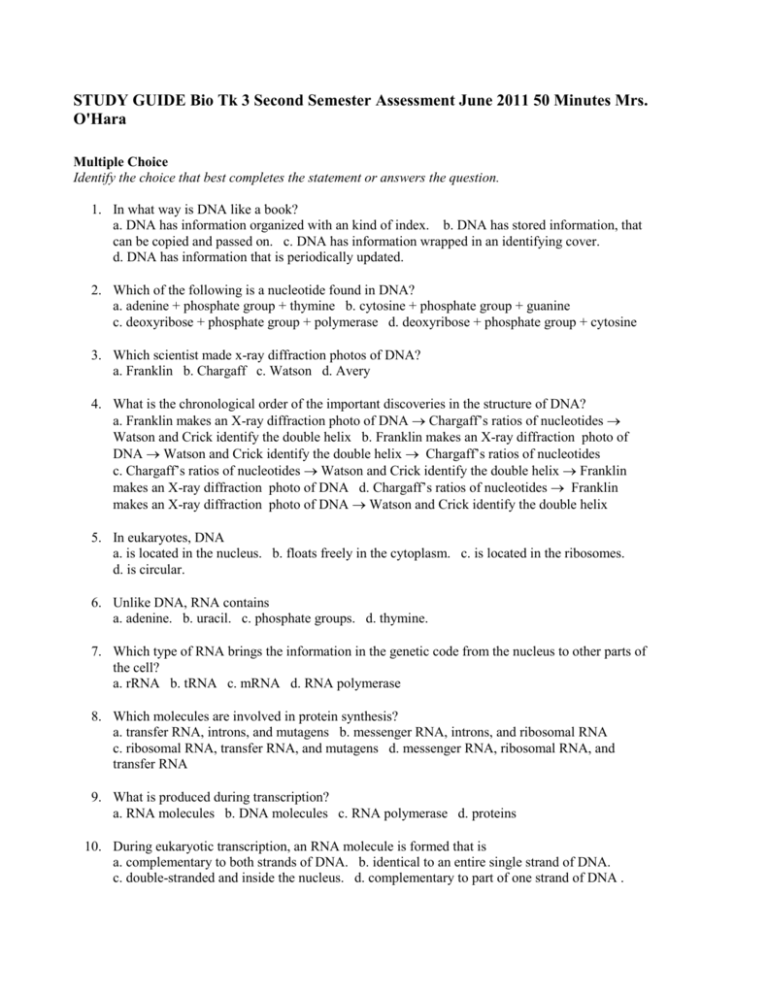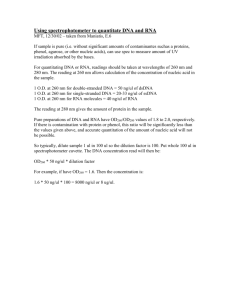STUDY GUIDE Bio Tk 3 Second Semester Assessment June 2011
advertisement

STUDY GUIDE Bio Tk 3 Second Semester Assessment June 2011 50 Minutes Mrs. O'Hara Multiple Choice Identify the choice that best completes the statement or answers the question. 1. In what way is DNA like a book? a. DNA has information organized with an kind of index. b. DNA has stored information, that can be copied and passed on. c. DNA has information wrapped in an identifying cover. d. DNA has information that is periodically updated. 2. Which of the following is a nucleotide found in DNA? a. adenine + phosphate group + thymine b. cytosine + phosphate group + guanine c. deoxyribose + phosphate group + polymerase d. deoxyribose + phosphate group + cytosine 3. Which scientist made x-ray diffraction photos of DNA? a. Franklin b. Chargaff c. Watson d. Avery 4. What is the chronological order of the important discoveries in the structure of DNA? a. Franklin makes an X-ray diffraction photo of DNA Chargaff’s ratios of nucleotides Watson and Crick identify the double helix b. Franklin makes an X-ray diffraction photo of DNA Watson and Crick identify the double helix Chargaff’s ratios of nucleotides c. Chargaff’s ratios of nucleotides Watson and Crick identify the double helix Franklin makes an X-ray diffraction photo of DNA d. Chargaff’s ratios of nucleotides Franklin makes an X-ray diffraction photo of DNA Watson and Crick identify the double helix 5. In eukaryotes, DNA a. is located in the nucleus. b. floats freely in the cytoplasm. c. is located in the ribosomes. d. is circular. 6. Unlike DNA, RNA contains a. adenine. b. uracil. c. phosphate groups. d. thymine. 7. Which type of RNA brings the information in the genetic code from the nucleus to other parts of the cell? a. rRNA b. tRNA c. mRNA d. RNA polymerase 8. Which molecules are involved in protein synthesis? a. transfer RNA, introns, and mutagens b. messenger RNA, introns, and ribosomal RNA c. ribosomal RNA, transfer RNA, and mutagens d. messenger RNA, ribosomal RNA, and transfer RNA 9. What is produced during transcription? a. RNA molecules b. DNA molecules c. RNA polymerase d. proteins 10. During eukaryotic transcription, an RNA molecule is formed that is a. complementary to both strands of DNA. b. identical to an entire single strand of DNA. c. double-stranded and inside the nucleus. d. complementary to part of one strand of DNA . 11. How many nucleotides are needed to specify three amino acids? a. 3 b. 6 c. 9 d. 12 12. What happens during translation? a. Messenger RNA is made from a DNA code. b. The cell uses a messenger RNA code to make proteins. c. Transfer RNA is made from a messenger RNA code. d. Copies of DNA molecules are made. 13. During translation, the type of amino acid that is added to the growing polypeptide depends on the a. codon on the mRNA and the anticodon on the rRNA. b. anticodon on the mRNA and the anticodon on the tRNA. c. anticodon on the rRNA and the codon on the mRNA. d. codon on the mRNA and the anticodon on the tRNA. 14. Genes contain instructions for assembling a. operons. b. nucleosomes. c. proteins. d. mutagens. 15. Which is the correct sequence of the transfer of information in most organisms? a. protein to DNA to RNA b. RNA to DNA to protein c. DNA to RNA to protein d. RNA to protein to DNA 16. In eukaryotes a. Transcription takes place in the cytoplasm, and translation takes place in the nucleus. b. Transcription takes place in the nucleus, and translation takes place in the cytoplasm. c. Transcription and translation both take place in the nucleus. d. Transcription and translation both take place in the cytoplasm. 17. Most mutations a. have no effect on an organism. b. are fatal to an organism. c. are helpful to an organism. d. are harmful to an organism. 18. Which of the following statements is true about gene regulation in prokaryotes? a. Promoters determine whether a gene is expressed. b. Expressed genes make more DNA. c. DNA-binding proteins determine whether a gene is expressed. d. RNA polymerase regulates gene expression. 19. The species of finches that Charles Darwin found on different Galápagos Islands varied in certain structural adaptations. One of the most significant adaptations that Darwin noted was the a. similarities of the birds’ embryos. b. birds’ different-shaped beaks. c. length of the birds’ necks. d. number of eggs in each bird’s nest. 20. Based on the adaptations Charles Darwin observed in finches and tortoises in the Galápagos, he wondered a. if species living on different islands had once been members of the same species. b. if finches and tortoises had originated from the same ancestral species. c. if all birds on the different islands were finches. d. why all tortoises on the different islands were identical. 21. Charles Darwin’s observation that finches of different species on the Galápagos Islands have many similar physical characteristics supports the hypothesis that these finches a. have the ability to interbreed. b. acquired traits through use and disuse. c. all eat the same type of food. d. descended from a common ancestor. 22. On the Galápagos Islands, Charles Darwin observed a. completely unrelated species on each of the islands. b. species exactly like those found in South America. c. species similar to mainland South American species. d. species completely unrelated to those found in South America. 23. Which of the following ideas is supported by Darwin’s observation of local variation among tortoises in the Galápagos Islands? a. artificial selection b. adaptation c. acquired characteristics d. tendency towards perfection 24. Darwin first began to formulate his concept of evolution by natural selection after a. experimenting with animals. b. observing patterns among the geographical location of certain species. c. reading the writings of Wallace. d. agreeing with Lamarck about the driving force behind evolution. 25. James Hutton’s and Charles Lyell’s work suggests that a. Earth is several million years old. b. Earth is several thousand years old. c. all fossils were formed in the last 1000 years. d. all rocks on Earth contain fossils. 26. James Hutton’s and Charles Lyell’s work was important to Darwin because these scientists a. explained volcanoes and earthquakes. b. explained all geologic events on Earth. c. suggested that Earth was old enough for evolution to have occurred. d. refuted the work of Lamarck, which was based on misunderstandings. 27. When a dairy farmer chooses to breed the cows that give the most milk in the herd, the farmers are following the principle of a. acquired characteristics. b. descent with modification. c. artificial selection. d. natural selection. 28. When a farmer breeds only his or her best livestock, the process involved is a. natural selection. b. artificial selection. c. artificial variation. d. survival of the fittest. 29. According to Darwin’s theory of natural selection, individuals who survive are the ones best adapted for their environment. Their survival is due to the a. possession of adaptations developed through use. b. possession of inherited adaptations that maximize fitness. c. lack of competition within the species. d. choices made by plant and animal breeders. 30. Which statement about the members of a population that live long enough to reproduce is consistent with the theory of evolution by natural selection? a. They transmit characteristics acquired by use and disuse to their offspring. b. They tend to produce fewer offspring than others in the population. c. They are the ones that are best adapted to survive in their environment. d. They will perpetuate unfavorable changes in the species. 31. Charles Darwin called the ability of an organism to survive and reproduce in its specific environment a. diversity. b. fitness. c. adaptation. d. evolution. 32. The principle of common descent helps explain why a. well-adapted species have many offspring. b. conditions in an organism’s environment ensures the organism’s survival. c. birds and reptiles share a number of inherited characteristics. d. tigers are so different from cheetahs. 33. The number and location of bones of many fossil vertebrates are similar to those in living vertebrates. This is evidence in support of which of the following concepts? a. Lamarck’s tendency towards perfection b. common descent c. analogous structures d. the inheritance of acquired traits Figure 16–1 34. In humans, the pelvis and femur, or thigh bone, are involved in walking. In whales, the pelvis and femur shown in Figure 16–1 are a. examples of fossils. b. vestigial structures. c. acquired traits. d. examples of natural variation. 35. Modern sea star larvae resemble some primitive vertebrate larvae. This similarity may suggest that primitive vertebrates a. share a common ancestor with sea stars. b. evolved from sea stars. c. evolved before sea stars. d. belong to the same species as sea stars. 36. Molecular evidence in support of natural selection includes a. the nearly universal genetic code. b. the presence of vestigial structures. c. a tendency toward perfect, unchanging DNA in various species. d. the transmission of acquired characteristics by DNA. 37. Similar patterns of embryological development in different but related organisms are responsible for the formation of a. homologous structures. b. analogous structures. c. Hox genes. d. intermediate fossil forms. 38. Three sources of genetic variation are a. genotypes, phenotypes, and polygenic traits. b. sexual reproduction, lateral gene transfer, and mutations. c. single-gene traits, polygenic traits, and adaptation. d. directional selection, disruptive selection, and stabilizing selection. 39. In organisms that reproduce sexually, most variation that can be inherited is due to a. mutations during gamete formation. b. polygenic traits. c. gene recombination during sexual reproduction. d. the effects of radiation. 40. The separation of populations by barriers such as rivers, mountains, or bodies of water is called a. temporal isolation. b. geographic isolation. c. behavioral isolation. d. genetic equilibrium. 41. A factor that is necessary for the formation of a new species is a. reproduction at different times. b. geographic barriers. c. different mating behaviors. d. reproductive isolation. 42. The geographic isolation of two populations of a species tends to increase differences between their gene pools because it a. prevents interbreeding between the populations. b. prevents interbreeding within each population. c. causes temporal isolation of the two populations. d. increases differences in courtship behavior. 43. One goal of scientists is to assign every organism a universally accepted name according to the system known as a. traditional classification. b. the three domains. c. binomial nomenclature. d. cladistics. 44. To be useful, a scientific name has to refer to a. all living species. b. all living and extinct species. c. all species in one habitat. d. a single species. 45. According to the rules of binomial nomenclature, which of the terms is capitalized? a. the genus name only b. the species name only c. both the genus and species names d. neither the genus nor species names 46. Based on their names, you know that the baboons Papio annubis and Papio cynocephalus do NOT belong to the same a. class. b. family. c. genus. d. species. 47. In Linnaeus’s system of classification, how many levels are there? a. one b. three c. five d. seven 48. A genus is composed of a number of similar a. kingdoms. b. phyla. c. orders. d. species. 49. Animals that are warm-blooded, have body hair, and produce milk for their young are grouped in the class a. Amphibia. b. Mammalia. c. Aves. d. Reptilia. 50. The grouping of organisms based on their common descent is called a. traditional classification. b. binomial nomenclature. c. derived characters. d. evolutionary classification.





